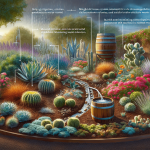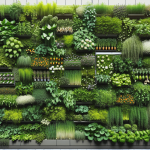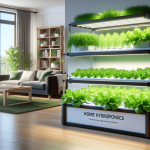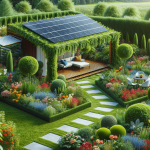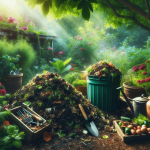This post may contain affiliate links. As an Amazon Associate, we may earn commissions from qualifying purchases.
Considering a fresh approach to making your garden both eco-friendly and flourishing? Implementing Hugelkultur beds for Sustainable Gardening in Your Backyard will guide you through the fascinating method of creating Hugelkultur beds, which capitalize on natural decomposition processes. By layering wood, plant matter, and soil, these raised garden beds enhance water retention, improve soil fertility, and boost plant health, all while reducing waste. You’ll soon discover how transforming your backyard with Hugelkultur can cultivate a more sustainable and fruitful gardening experience. How can you implement hugelkultur beds for sustainable gardening in your backyard?
Congratulations on taking the first step towards sustainable gardening in your backyard! You’ve likely heard the term “hugelkultur” tossed around in gardening circles and wondered what it’s all about. Well, you’re in the right place. Hugelkultur is a fascinating, old-world technique that’s making a significant impact in modern sustainable gardening practices.
What Is Hugelkultur?
A Brief History
Hugelkultur, which translates to “hill culture” or “mound culture” in German, has origins in Eastern Europe and Germany. This method involves creating raised garden beds filled with decaying wood and plant material, which slowly decomposes over time. The result is a highly fertile, self-sustaining planting bed that mimics the natural ecosystem of a forest floor.
The Concept
At its core, hugelkultur utilizes the natural process of decomposition. When wood and other organic materials break down, they create a nutrient-rich environment perfect for growing plants. At the same time, these materials help retain moisture, reducing the need for frequent watering. This makes hugelkultur an ideal choice for sustainable gardening.
Why Choose Hugelkultur?
Benefits of Hugelkultur
Opting for hugelkultur beds brings numerous advantages:
| Benefits | Description |
|---|---|
| Water Retention | Hugelkultur beds hold moisture much more effectively than traditional garden beds. |
| Soil Fertility | As the wood decomposes, it enriches the soil, providing essential nutrients to your plants. |
| Reduced Waste | Recycling yard waste and tree debris helps reduce the amount of material that ends up in landfills. |
| Improved Soil | The structure of hugelkultur beds improves soil aeration and drainage. |
| Long-Lasting | Once established, hugelkultur beds continue to improve over the years, requiring less maintenance. |
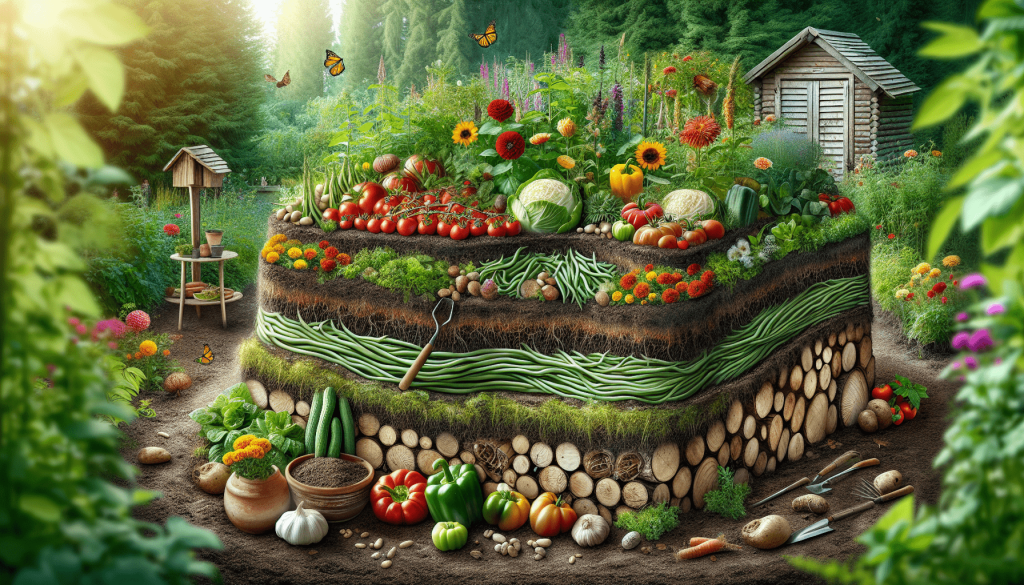
Planning Your Hugelkultur Bed
Choosing the Right Location
Picking the ideal spot in your backyard is the first step. Since hugelkultur beds can get quite large, be sure to choose an area with plenty of space. Consider these factors:
- Sunlight: Most vegetables and herbs require at least 6-8 hours of sunlight daily.
- Access to Water: Although hugelkultur beds retain water well, having a nearby water source is always helpful.
- Proximity to Other Plants: Ensure your bed won’t overshadow or interfere with existing plants.
Size and Shape
Your hugelkultur bed can be any size or shape, depending on your available space and personal preference. Most gardeners opt for:
- Height: Typically, 3-5 feet high. Higher beds tend to hold more moisture and require less watering.
- Length and Width: Generally, 3-4 feet wide to allow easy access to the center of the bed from either side.
Materials Needed
To construct your hugelkultur bed, you’ll need the following materials:
- Core Wood: Logs, branches, and twigs. Hardwood and older wood work best because they decompose slowly.
- Filling Material: Grass clippings, leaves, straw, compost, and other organic matter.
- Top Layer: Good-quality garden soil and compost mix for planting.
Building Your Hugelkultur Bed
Step 1: Lay the Foundation
Start by digging a trench where the bed will sit if you want extra stability and moisture retention. A trench about 1-2 feet deep should suffice.
Step 2: Add the Core Wood
Fill the trench with your core wood materials. Larger logs and branches go at the bottom, followed by progressively smaller materials like twigs and sticks. Arrange them in a crisscross pattern to create air pockets, which aids in decomposition and soil aeration.
Step 3: Layer Organic Matter
Next, add a layer of organic matter on top of the wood. This can include grass clippings, leaves, straw, and garden compost. This layer helps to kickstart the decomposition process and provides essential nutrients.
Step 4: Add Soil
Lastly, cover the entire bed with a mix of garden soil and compost. This top layer should be thick enough to support your plants and create a healthy growing environment.
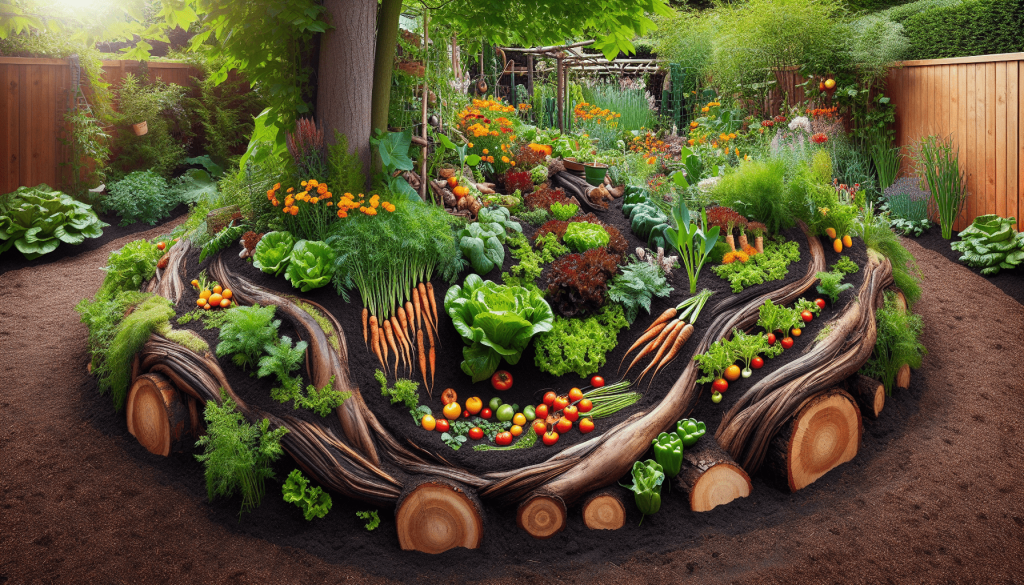
Choosing What to Plant
Ideal Plants for Hugelkultur Beds
Hugelkultur beds are versatile and can support a wide range of plants. Here are some popular choices:
| Plant Type | Examples |
|---|---|
| Vegetables | Tomatoes, peppers, cucumbers, zucchini, carrots, potatoes, and lettuce |
| Fruits | Strawberries, raspberries, blueberries, and melons |
| Herbs | Basil, parsley, mint, rosemary, and thyme |
| Flowers | Marigolds, sunflowers, zinnias, and cosmos |
Planting Seasons
Different plants thrive in specific seasons. Here’s a quick guide:
- Spring: Lettuce, peas, radishes, and spinach.
- Summer: Tomatoes, peppers, cucumbers, and squash.
- Fall: Kale, carrots, beets, and broccoli.
- Winter (Mild Climates): Garlic, onions, and certain types of kale and spinach.
Maintaining Your Hugelkultur Bed
Watering
Initially, you may need to water your hugelkultur bed more frequently to help it establish. Once the wood starts to decompose, it will retain moisture very effectively. Monitor the soil moisture and water as needed.
Mulching
Adding a layer of mulch on top of your hugelkultur bed can help retain moisture, suppress weeds, and add organic matter as it breaks down. Straw, wood chips, and leaves work well.
Fertilizing
Although hugelkultur beds are nutrient-rich, you might need to supplement with organic fertilizers occasionally. Compost tea, well-rotted manure, or organic plant food can provide an extra boost.
Managing Pests
As with any garden, pests can be a challenge. Encourage beneficial insects and use organic pest control methods to keep your plants healthy. Companion planting, such as growing marigolds near your vegetables, can also help deter pests.
Common Questions and Troubleshooting
What If My Hugelkultur Bed Isn’t Retaining Water?
If you notice that your hugelkultur bed isn’t retaining water as expected, it could be due to several reasons:
- Wood Type: Ensure that you’re using hardwood and older wood that decomposes slowly and retains moisture well.
- Layering: Check if the layers of organic matter and soil are sufficient to retain moisture.
- Initial Watering: Make sure you thoroughly water the bed when you first set it up.
Why Aren’t My Plants Growing Well?
There are multiple factors that could affect plant growth in a hugelkultur bed:
- Soil Quality: Ensure that the topsoil and compost layer is of high quality and nutrient-rich.
- Drainage: Hugelkultur beds typically have good drainage, but if your bed is too compacted, it might be restricting root growth.
- Sunlight: Verify that your bed is getting adequate sunlight for the plants you’ve chosen.
How Long Will My Hugelkultur Bed Last?
A well-built hugelkultur bed can last for several years. The bed will settle and decompose over time, creating a rich, fertile soil. Replenish the top layer with compost and organic matter as needed to maintain productivity.
Advanced Hugelkultur Techniques
Multiple Beds
As you become more comfortable with hugelkultur, you may want to expand by creating multiple beds. This can allow for crop rotation and more diverse planting options.
Integrating Hugelkultur with Other Gardening Methods
Hugelkultur can be integrated with other sustainable gardening practices, such as permaculture and companion planting, to create a more robust and productive garden ecosystem.
Experiment with Bed Shapes
Traditional hugelkultur beds are mounded, but you can experiment with different shapes and sizes to fit your garden layout and aesthetic preferences. Some gardeners create circular beds, spirals, or even keyhole-shaped beds.
Conclusion
Implementing hugelkultur beds in your backyard can transform your gardening experience into a more sustainable and fruitful endeavor. By understanding the principles, advantages, and methods involved, you’ll be well-equipped to create a thriving garden that benefits both you and the environment.
You’ve embarked on an exciting journey toward sustainable living and resilient gardening practices. Enjoy the process, and happy gardening!

